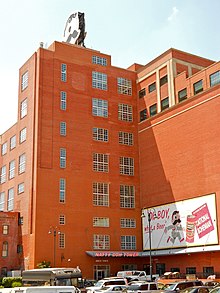National Brewing Company
The National Brewing Company was an American brewery in Baltimore that was founded in 1885 and merged with the Carling Brewing Company to form Carling-National Breweries in 1975 .
history
Foundation to prohibition
The Wunder Brewery in Baltimore, founded by Frederick and Anna Wunder in 1872, was part of the H. Straus Bro malt company. & Bell in debt. This brewery was on the corner of O'Donnell and 3rd Street (now Conkling Street) and produced, among other things, the National Premium beer brand. The H. Straus Bro. & Bell was headed by Henry and Levi Straus and Alexander Bell, a brother-in-law of Peter Ballantine . To settle the debt, the Wunder Brewery was taken over by Levi's sons Joseph L. and William L. Straus in 1885.
The Straus brothers renamed the brewery the National Brewing Company . Over the next two years, they invested approximately $ 125,000 in renovating the facilities. The investments paid off: the brewery quickly established itself in the Baltimore market. In 1892 a fire destroyed large parts of the brewery. By 1899, around 100,000 US dollars were again invested in repairing the damage and the National Brewing Company developed into the second largest brewery in Baltimore.
In 1899, the brewery became part of the Maryland Brewing Company , a consortium that included several breweries, including the Globe Brewing Company and the Gunther Brewing Company . Two years later this conglomerate was reorganized into the Gottlieb-Bauernschmidt-Straus Brewing Company. In 1912 a second bottling plant with a daily capacity of 100 barrels was built.
On January 16, 1920, the brewery was closed as a result of Prohibition . The facilities were sold and the buildings were taken over by the Linthicum Realty Company on November 18, 1925.
End of prohibition and expansion
With the end of Prohibition, the National Brewing Company was reopened on May 17, 1933 under the new owner Samuel Hoffberger. The old brewery buildings were renovated, new equipment was procured and additional buildings were erected: Another brewery, bottling plant, and cooling and storage rooms. At that time, the brewery had an annual production capacity of around 250,000 barrels.
Within six months, the demand for National beer, namely the National Bohemian and National Premium brands, increased so much that the brewery expanded again and finally reached an annual output of 438,000 barrels. In 1933 the company mascot, Mr. Boh, was introduced. Its name is derived from the shortened pronunciation of National Bohemian ("Natty Boh").
In 1940 the bottling house was extended by another floor. After the end of the Second World War , Hoffberger's son Jerold joined the company as treasurer in 1945. A year later he became president.
In 1952 a new ten-story brewery was built. Two years later, the National Brewing Company began acquiring smaller breweries: Altes Brewery (1954, Detroit ), Marlin Brewery (1956, Orlando ), production site of the Anheuser-Busch Brewery (1961, Miami ). With the purchase of the brewery in Miami, production in Orlando was stopped.
1950s and merger with Carling
The National Brewing Company was sponsoring the Baltimore Colts at the time . In 1963 the brewery introduced the Colt 45 malt liquor brand, which is still popular today. Their name is said to be derived from the Colts player Jerry Hill, who wore the number 45.
In 1964 the brewery reached an annual output of 1,000,000 barrels. Two years later the Carling Brewery ( Phoenix ) was acquired, which also involved taking over sponsorship for the Baltimore Orioles . In 1973 the Detroit brewery was closed.
In 1975 the Carling Brewing Company ( Cleveland ) and the National Brewing Company were merged to form Carling-National Breweries , Inc. The brewery in Miami was then closed.
The National Brewing Company buildings in Baltimore were not demolished and can still be seen today. The buildings, some of which were planned by Otto Wolf (beer cellar from 1899) and Paul W. Backhus (parts of the building from 1933), have been listed in the National Register of Historic Places as architectural monuments since 2002 .
literature
- David G. Moyer (2009), American Breweries of the Past , Bloomington (Indiana): AuthorHouse, pp. 60–61 (English)
Web links
Individual evidence
- ↑ The National Brewing Company in: National Register of Historic Places: Maryland, accessed December 1, 2015.
